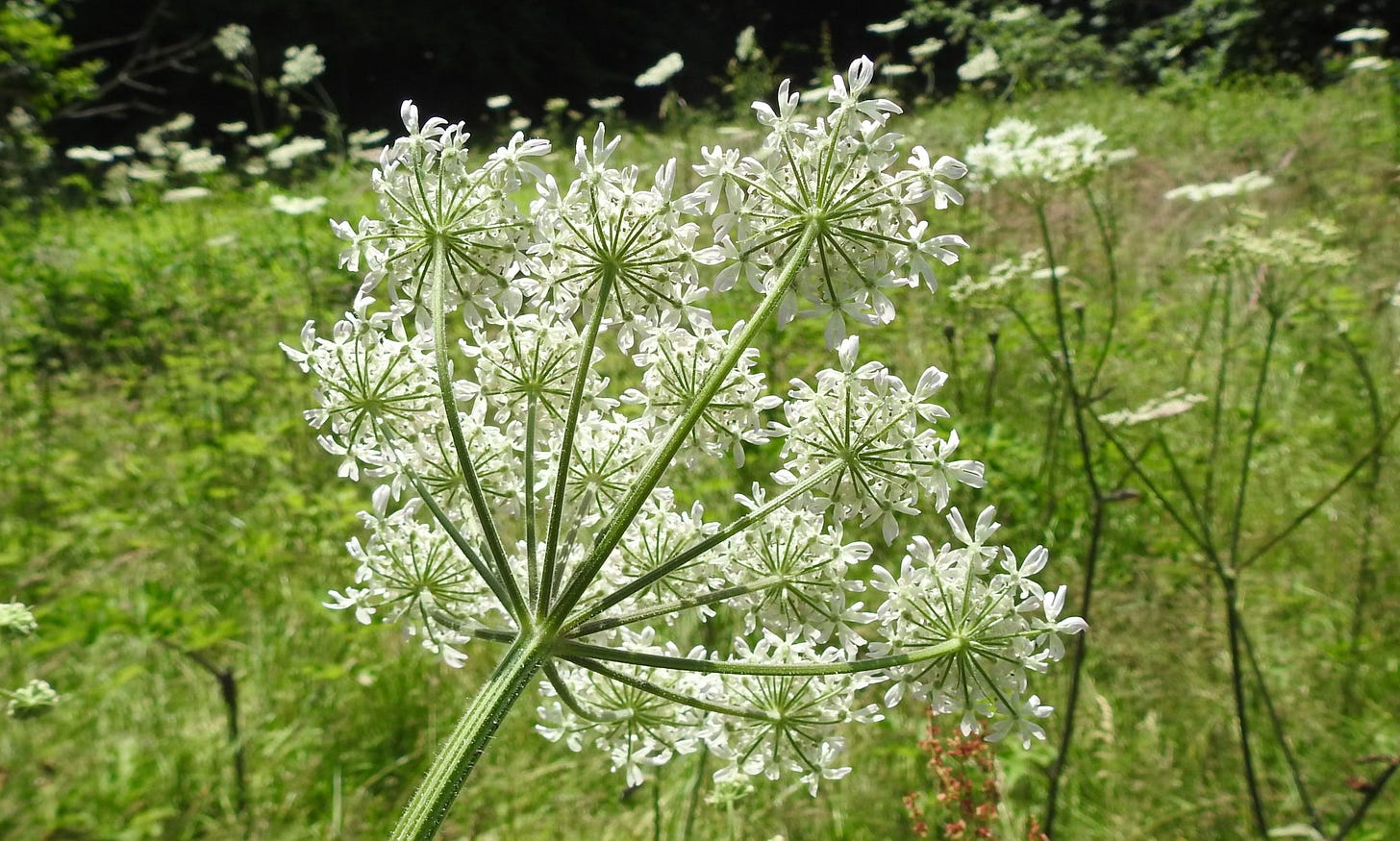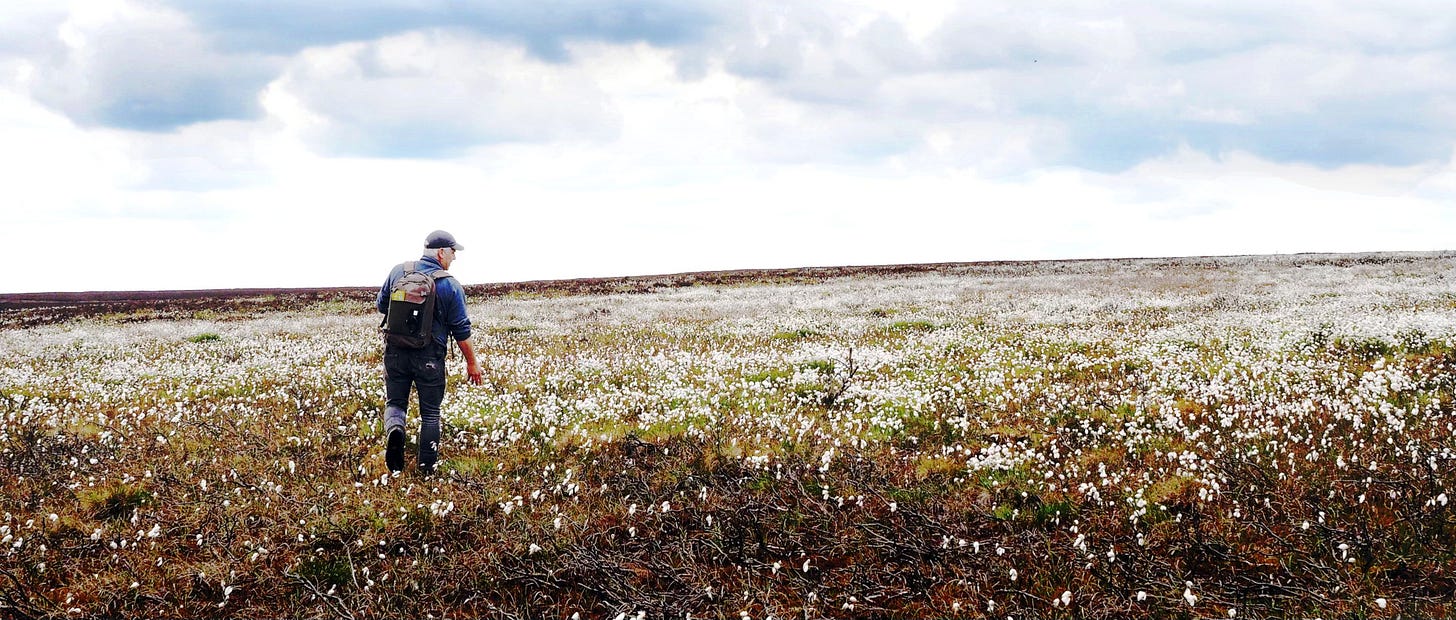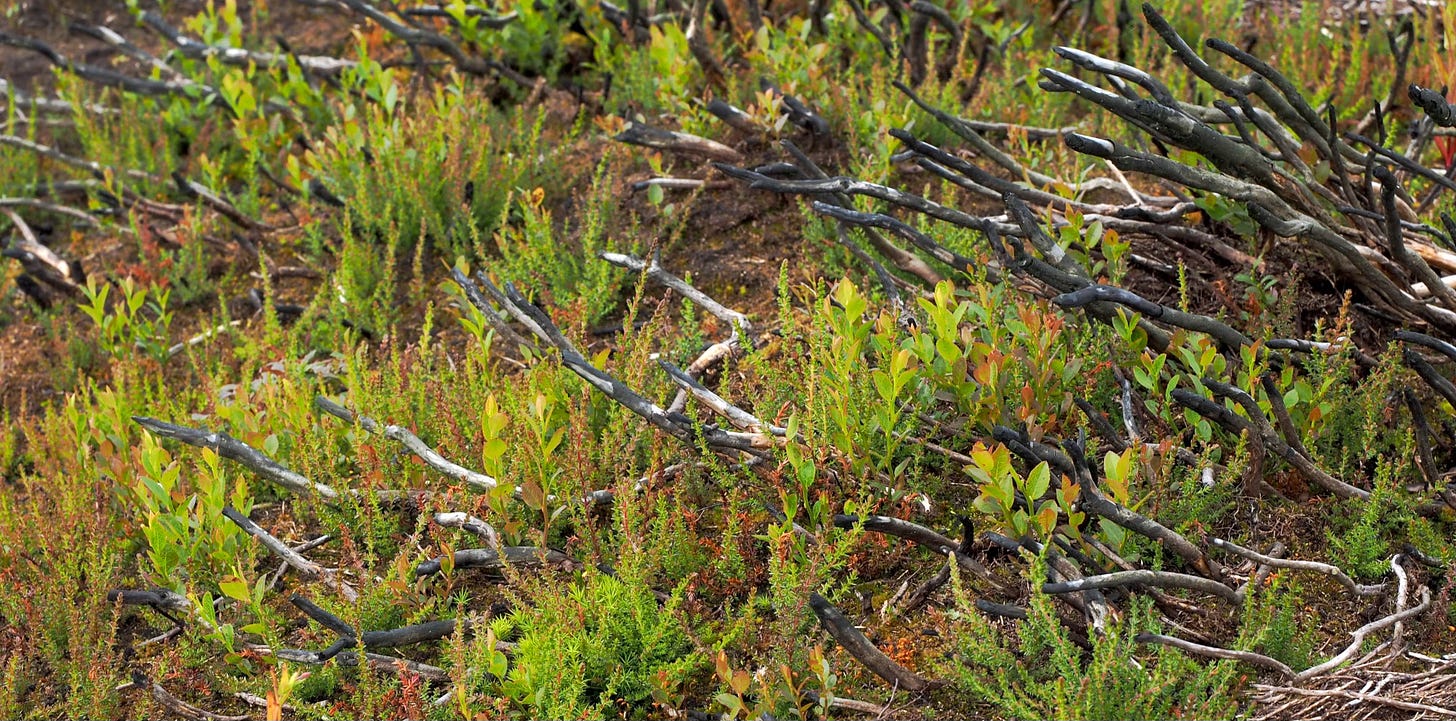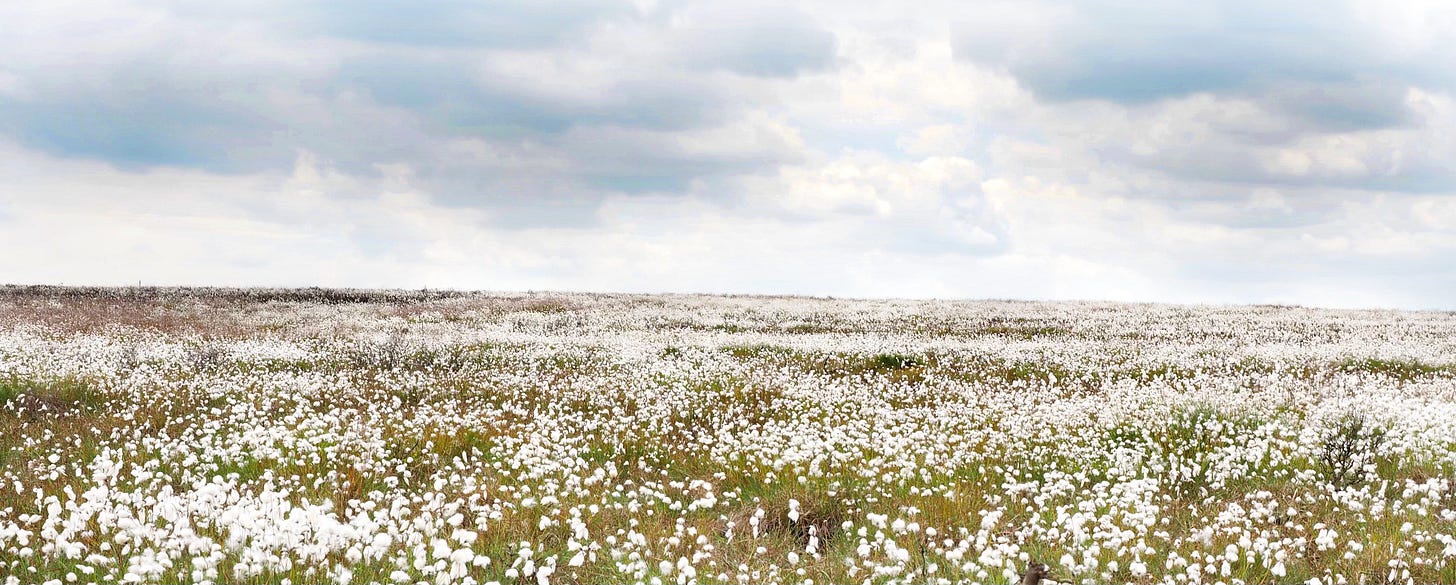White, Green & Wet - The Colours of Moorland: Sun 23rd June 2024
Dreaming of a white Burbage. Plus meadow methods, brief news and the 24 hour (small) park run.
Morning. Just over a year after the huge fire on Burbage Moor the landscape has changed. Being wild things, the surviving plants and creatures got on with trying to stay alive after the inferno in their own way, and some of those changes may not be what you’d expect. I spoke to the landscape manager up there to learn why green and white moors are better than purple.
This week I’ve also got another miscellany of stories and happenings. I’m still trying to find a way to cover more news as it comes in. The truth is, keeping up with the life of the Outdoor City takes quite a bit of time and effort.
This is a social enterprise publication, with over 220 members, and we’re edging closer to our target of paying subscribers needed to cover a wider range of features, and keep a little more up to speed on what’s going on out there, but if you’ve been reading on your free trial for a month or two already, we need your help.
The sums are simple: with 250 or more of you chipping in, we’ll generate enough revenue to cover two days a week of writing, researching, hustling, hassling and photographing, at around the minimum wage.
So if you’ve been enjoying your free trial, all we need from you is £4 a month to help us grow and thrive for all our readers. Or go annual (and get a month free) for half the price of an official Taylor Swift blanket.
Biggest Big Run Yet
I gather there are more runners than ever pounding round the 24 hour Small Park, Big Run in Meersbrook Park just now. At least one of them is aiming to run the 1km circuit around the mountainous park (as I imagine it feels at 3am) for the full 24 hours, and Jonathan Feldman from the organising team tells me there are entrants from as far away as London, Cornwall and Edinburgh.
The run, which raises money for educational and children’s projects in Palestine, continues this (Sunday) morning until noon, and I understand you may still be able to sign up at the Meersbrook Hall run HQ for a circuit or two. You can certainly go down and listen to music, cheer on the runners and support the event, which hopes to have a live link up with Ramallah and possibly Gaza on Sunday. I’ll be chatting to Jonathan about land, space, play and running in wartime for next week’s post.
Meadow Larks
There’s much talk about mowing and meadows just now: the council’s hard pressed ranger teams have been out strimming miles of public rights of way to keep them open, while working out how to manage the city’s parks and green spaces for insects, butterflies and other wildlife, which have no interest in bowling green style lawns, but enjoy raising families in wild grassland. (I hope to have more on this subject next week).
I’m told the move to ‘relaxed’ mowing regimes is ongoing, and on Thursday Professor Ian Rotherham and colleague Karon Mayor will be leading a Magical Meadows walk at Graves Park to look at why good meadow management is so important for biodiversity, and, to be frank, beauty.
Parkwood Primed
The new cafe (and toilets) at Parkwood Springs should be open within two weeks. The wooden kiosk (similar to the one at Ecclesall Woods) is in place, and I gather will be offering fine Turkish coffee, sandwiches and cakes to visitors arriving to explore the new trails opening up on the former landfill site this year.
The Friends of Parkwood Springs are in the process of naming some of those trails for posterity: I hear that Henderson’s Relish are supporting the new inner city park in their home city, probably by sponsoring one of the new routes for visitors. (The original batch of Hendo’s was brewed by Henry Henderson in his kitchen on Green Lane, just below Parkwood Springs).
Fences have already disappeared in some areas to open up about 20 football fields worth of new hilltop land to explore. The Parkwood Springs parkrun is still on its way this year, but due to the complexities of approval and funding, a late summer or early autumn start date is most likely. The Country Park for the City, in the planning for over a decade, is finally here.
Run Sheffield
The 2nd issue of the new running magazine for Sheffield is out now: editor John Taff tells me it’ll be on sale (for £5) at La Bilbioteka and My Race Kit North as usual, and he’ll be touring local races with a stash of copies for sale too.
Green, White and Wet
The colours of moorland, you might think, should either be a mixture of brown, grey and British racing green, or purple, depending on the season.
“Look at that,” says Danny Udall, manager of the Eastern Moors Partnership. “Green, white and wet,” he observes, happily. Far out over the white moor beyond the Ox Stones, a Golden Plover is calling.
A year ago I visited this stretch of Burbage Moor when it was black, grey and still smoking after the huge fire that engulfed the moor overnight at the end of the May heatwave. Last week Danny took me to see how nature had reacted to the inferno that blew almost as far as Burbage Edge, killing acres of wildlife as it burned.
You can still see where the fire started a few yards from the Ox Stones - last year the shape of a portable barbecue was still visible, faded now, but you can still make out where the fire surged out before a north east wind fanned it away across the moorland.
On the blackened peat, there are signs of life, but Danny is not at all happy about the new growth coming through. Thousands of young heather shoots are sprouting where the fire swept by, which will grow to become a new fire risk, he explains. Heather is adapted to fire, with new shoots growing well after burning, and then becoming highly flammable as they age.
Nearby, there’s an apparently unburned area: here the heather was cut by the Eastern Moors team about three years ago, Danny says, and this patch acted as a kind of fire break in May 2023. Where the blaze had no woody heather to engulf, it moved on to more flammable patches of dry older heather.
Danny saw the fire from his home in Chesterfield 12 miles away, and quickly joined the Derbyshire and South Yorkshire fire service teams to try and control the spread of the blaze. The cut heather fire breaks helped the fire crews that night, he explains. “Heather on a bog transmits fire,” he says.
The old heather is a remnant from the Duke of Rutland’s grouse shooting days, and later grazing by large herds of sheep, who also enjoyed young heather shoots. But moors comprising never-ending acres of heather are not natural, says Danny.
We head out into the Cotton Grass, growing profusely this year probably due to the rain we’ve had so far, and the ground being wetter away from the burned moor. Danny is looking for the bright green amongst the white, and soon finds it: sphagnum mosses. Over the winter, teams of volunteers help plant plugs of sphagnum on many of the moors around Sheffield, and here on Burbage many are now growing, holding water into the ground.
We find a huge lump of green vegetation rising half a metre from the peat soil: the mosses on it have been growing for decades, but a clump like it has probably been here for thousands of years, says Danny, soaking up water and decaying into peat long before humans arrived with their land management ideas.
For a natural wet moorland bog, you need more bright green sphagnum and less purple heather, and those damp conditions allow Cotton Grass to grow. White, green and wet, you see. And those conditions attract loads of insects and birds and other wildlife.
Last week we saw or heard Curlew and Golden Plover around the damp white moor, but there’ll be Snipe around too, says Danny. On the blackened burned heather moor, it was deathly quiet.
The rain this year does not mean there’s no fire risk, as the signs on moorland gates tell us. Heather is still flammable, and soon dries out after rain. But people are still carrying in fires and barbecues, oblivious to the risk of setting a moor ablaze, killing virtually everything that lives there, costing hundreds of thousands of pounds (a single helicopter used to control the Saddleworth fire last year cost £400,000 says Danny) and wasting the time and heroic efforts of hundreds of firefighters and volunteers.

The Eastern Moors Partnership have a team of volunteers who help their staff watch for fires, and people arriving on the moors to start them. Danny says 100% of potential recreational fire incidents reported were stopped last year, with over 98% of the people involved leaving the moor after learning why fires on the moor are a very bad idea.
The majority of recreational fires are set within half an hour of dusk, he adds, and local studies show that although 2/3 of the people involved have travelled from less than an hour away, often from cities like Nottingham, Derby or Sheffield, a third have come from all over the UK. They travel to enjoy the Peak District, Danny says, and for some that enjoyment involves taking a cheap tent and lots of beer and a barbie up onto the moors for the night.
But there is another, even more alarming kind of recreational fire, where the fire itself is the recreation, and Danny reveals that a significant minority of the UK’s moorland fires are set by people who intend to set the moors alight, for reasons unknown, in some cases, using a portable barbecue as ignition.
But none of these fires started by people should be called accidental, says Danny. “The barbecues don’t arrive here on the moors by accident,” he says.
After being encouraged to proliferate on our moors since Victorian times, the acres of flammable purple heather are not accidental either, but by cutting, and encouraging or planting sphagnum mosses and Cotton Grass, the moors are gradually turning wetter and wilder and less likely to set alight when an ignorant party-goer or arsonist arrives with a fire one evening. More heather cutting would help too, says Danny, as finances allow.
As we head back over the moor, snowy seeds of Cotton Grass blow away from our footsteps, spreading white, green and wet into two centuries of purple and black and burning.
“Cotton grass is a lot more beautiful than heather,” says Danny.
To volunteer for our moorland (including fire watching) contact Eastern Moors Partnership the National Trust or Peak District National Park
Selected What’s On Out There (from Sun 23rd June)
See our full listings service here. And please share with your outdoorsy mates too. I try and update the What’s Out There post every few days so you can always find things to get up to. If you appreciate all my work on this, please subscribe!
Sat 22nd / Sun 23rd - Small Park, Big Run 24 hr run and events at Meersbrook Park
Sat 22nd / Sun 23rd - RSPB Local Group open days at Sheffield Botanical Gardens
Mon 24th - Sheffield Area Social Cycling Group picnic ride from Norfolk Arms to Ladybower (31m)
Tues 25th - Friends of Porter Valley work morning
Thurs 27th - Green City Action Grimesthorpe community allotment volunteer days
Thurs 27th - Graves Park Digging Deeper For All - Meadow Walk (booking required)
Sat 29th - Parents for Future Moorland Picnic for families at Surprise View (11 - 2)
Sun 30th - Trust 10 Trails - Guided Run from Edale station
Thanks for reading. Becoming a full paid subscriber means you can read all 163 posts in our archive, including all the monthly wildlife round ups, and lots more. And you’ll be helping us grow and reach even more of the Outdoor City. Remember our slogan:
F.F.S! Forward to Friends, and Subscribe!












I enjoy your posts so much David, partly because I always learn something. This time it was how heather is the wrong species to proliferate on the moors. Like many people, I see the beautiful purple moors and imagine how deliciously bleak and wild it is, not realising that the heather is there for the benefit of the wealthy (and slightly unhinged) few whose egos need the boost of killing something that doesn’t have a gun itself. I now understand how much more important the sphagnum moss is!
I also learnt how to spell sphagnum…. 🙄
I love seeing heather moorlands in bloom but I have also been loving learning more about what a healthy moorland actually looks like! I only saw/noticed cotton grass for the first time a couple weeks ago and it was so beautiful.
This is a timely article ahead of our Parents For Future picnic on Saturday. Some folks from the Eastern Moors Partnership will be joining us. :)